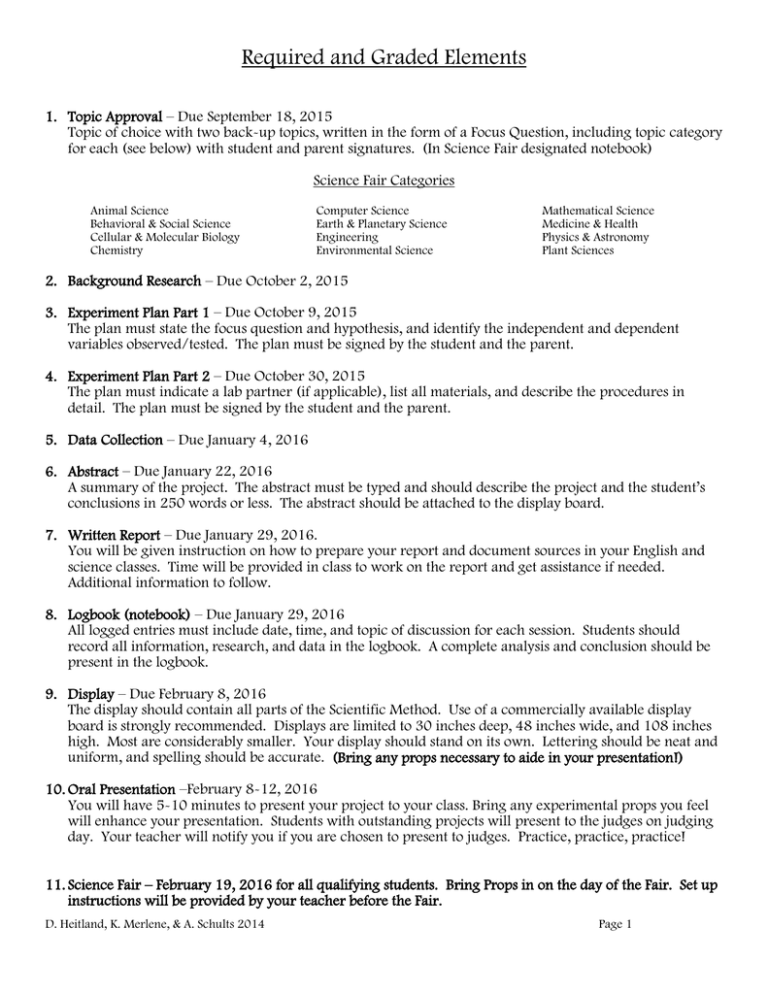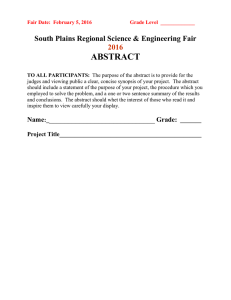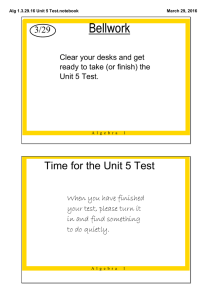Required and Graded Elements
advertisement

Required and Graded Elements 1. Topic Approval – Due September 18, 2015 Topic of choice with two back-up topics, written in the form of a Focus Question, including topic category for each (see below) with student and parent signatures. (In Science Fair designated notebook) Science Fair Categories Animal Science Behavioral & Social Science Cellular & Molecular Biology Chemistry Computer Science Earth & Planetary Science Engineering Environmental Science Mathematical Science Medicine & Health Physics & Astronomy Plant Sciences 2. Background Research – Due October 2, 2015 3. Experiment Plan Part 1 – Due October 9, 2015 The plan must state the focus question and hypothesis, and identify the independent and dependent variables observed/tested. The plan must be signed by the student and the parent. 4. Experiment Plan Part 2 – Due October 30, 2015 The plan must indicate a lab partner (if applicable), list all materials, and describe the procedures in detail. The plan must be signed by the student and the parent. 5. Data Collection – Due January 4, 2016 6. Abstract – Due January 22, 2016 A summary of the project. The abstract must be typed and should describe the project and the student’s conclusions in 250 words or less. The abstract should be attached to the display board. 7. Written Report – Due January 29, 2016. You will be given instruction on how to prepare your report and document sources in your English and science classes. Time will be provided in class to work on the report and get assistance if needed. Additional information to follow. 8. Logbook (notebook) – Due January 29, 2016 All logged entries must include date, time, and topic of discussion for each session. Students should record all information, research, and data in the logbook. A complete analysis and conclusion should be present in the logbook. 9. Display – Due February 8, 2016 The display should contain all parts of the Scientific Method. Use of a commercially available display board is strongly recommended. Displays are limited to 30 inches deep, 48 inches wide, and 108 inches high. Most are considerably smaller. Your display should stand on its own. Lettering should be neat and uniform, and spelling should be accurate. (Bring any props necessary to aide in your presentation!) 10. Oral Presentation –February 8-12, 2016 You will have 5-10 minutes to present your project to your class. Bring any experimental props you feel will enhance your presentation. Students with outstanding projects will present to the judges on judging day. Your teacher will notify you if you are chosen to present to judges. Practice, practice, practice! 11. Science Fair – February 19, 2016 for all qualifying students. Bring Props in on the day of the Fair. Set up instructions will be provided by your teacher before the Fair. D. Heitland, K. Merlene, & A. Schults 2014 Page 1 Suggested Time Line September 4-September 11: Gather ideas for Science Fair Project September 14-September 18: Topic Selection October 5-October 23: Write Experiment Plan October 26-December 18: Perform Experiment January 4-January 15: Write Analysis and Conclusion January 19-January 22: Write Abstract January 25-January 29: Prepare Display Board February 1-Feburary 5: Practice Oral Presentation Science Fair Rules and Regulations 1. Before beginning any scientific project, students must get the topic approved by his/her science teacher. 2. Students must develop their projects either individually or through a team effort of no more than three students as this complies with the AzSEF rules. The research and display must be entirely the work of the student(s). Students may, however; seek the advice and technical assistance of their teacher and/or qualified mentors. 3. No one may enter more than one project in each category. 4. All exhibits must be durable and safe. If requested, electrical power outlets will be available to the exhibitor. However, no other equipment will be provided including extension cords. 5. No animals, chemicals, or hazardous materials/objects may be exhibited. If you are unsure of the safety of an experiment, see your teacher first. 6. The student’s name, school, grade, teacher’s name, and category MUST appear on the back of the display board. See science teacher for specific placement. 7. Only judges, committee members, and participants will be allowed in the exhibit room during judging. 8. Specific set-up and take-down times will be determined by the school. It is the responsibility of the exhibitors to set up and take down their exhibit in a timely manner. 9. All students must keep a designated Science Fair logbook/notebook throughout the length of the project. Logbooks need to be graph paper composition notebooks as they are the only approved notebook by the Arizona State Science Fair. The judges give high marks for complete, detailed notebooks! 10. All judging is FINAL. All evaluations as to safe conduct, appropriateness of displays, projects, and safety are solely the responsibility of the school officials and judges. Judges will select winners based on the display and an interview with the student. Winning students will have the opportunity to compete at AzSEF. D. Heitland, K. Merlene, & A. Schults 2014 Page 2


